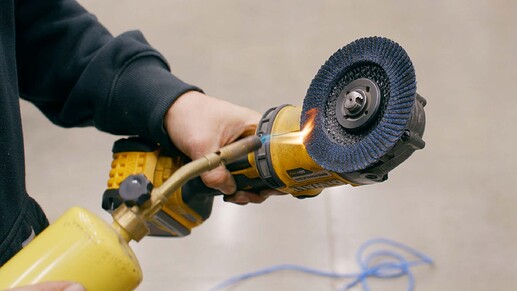As you guys know I have tested a ton of grinding discs, and I have a bucket full of them that still have plenty of material left, but their cutting power has disappeared. Instead of tossing them out, I decided to test a bunch of myths I found online to see if I could get them cutting like new again, and made a video about them.
Myth #1: Grinding on Concrete Will Fix a Glazed Disc
The idea behind this is that grinding the disc on concrete will wear away the glazed material, revealing fresh abrasive underneath. I tried it out, but the results weren’t impressive. The disc didn’t cut any better, and I think it just caused more damage. If you’re looking to salvage a worn-out flap disc, this isn’t the solution.
Myth #2: Grinding Against a Hard Disk Will Revive It
Next, I tested grinding the glazed disc against a hard metal disk, which is supposed to remove the glaze and expose fresh abrasive. Unfortunately, this didn’t work well either. It actually made the disc perform even worse. The hard disk obliterated the flap disc, and I didn’t get any improvement in cutting power. Definitely a bust.
Myth #3: Using a Diamond Wheel Will Help
Some people swear by grinding a flap disc on a diamond wheel to break the glaze. I gave it a try, but the result wasn’t great. It didn’t remove the glaze, and it seemed to make the fabric even worse. So, if you’re thinking of trying this one, I wouldn’t bother.
Myth #4: Running the Disc Backwards Will Remove the Glaze
Now we’re getting somewhere. This myth suggests that running the disc in reverse could catch the bad media and peel it off. I was skeptical, but to my surprise, it worked. The backward grinding definitely made a noticeable improvement—better than all the other methods I’d tested so far. If you’re going to try one method, this would be the one.
Myth #5: Freezing the Disc Will Break the Glaze
This one was a long shot, but I gave it a go. The idea is that freezing the disc would make the glue and glazed material brittle, so it would break off when grinding. Spoiler alert: it didn’t work. The disc performed exactly the same after freezing, so don’t waste your time with this one.
Myth #6: Using an Open Flame Will Burn Off the Glaze
I wasn’t sure about this one either, but I had to try it. The idea is that an open flame could burn off the glazed material, leaving fresh abrasive behind. While it did seem to make the disc feel grippier, I can’t say it was a game-changer. It worked a little, but not enough to make it a go-to solution.
Myth #7: Soaking in Water Will Loosen the Glaze
Some myths are simpler, and this one was about soaking the disc in water. The theory is that it might soften the fibers and glue enough to get the glaze to break off. After soaking it for a while, I didn’t see anything dramatic, but there was a slight improvement when I put the disc back to work. It wasn’t huge, but it did help a little.
Myth #8: Carburetor Cleaner Will Dissolve the Glaze
Last but not least, I tested carburetor cleaner, which supposedly loosens the fibers and glue on the flap disc. For safety’s sake, don’t try this at home—it’s highly flammable. After soaking the disc for a while, I could see some of the material coming off, but the results were underwhelming. It didn’t really revive the disc the way I hoped.
In the end, I learned a few things. Some of these myths were flat-out false, while others, like running the disc backward or soaking it in water, made a difference. If I had to pick one method that worked best, it would definitely be the backward grinding. But, as always, there’s a disclaimer—this method is a bit risky.









